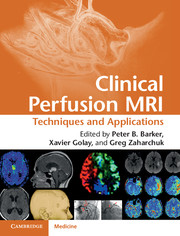Foreword
Published online by Cambridge University Press: 05 May 2013
Summary
Diseases of the brain remain the largest single cause of human suffering worldwide [1], and an extraordinarily wide range of symptoms can be observed with brain ischemia, including both acute and chronic neurological and/or psychological deficits. These two facts have prompted a very long quest to better understand, observe, and quantify blood flow in the living human brain – more than a century-long quest, in fact [2]. The advent of in vivo advanced imaging techniques in humans has therefore perhaps naturally been put to use to study blood flow to the brain, and indeed all organs.
While routine imaging of the larger vessels has become relatively straightforward, with a variety of imaging methods ranging from ultrasound to X-rays and beyond to magnetic resonance imaging (MRI), the measurement of tissue-level blood flow has been more challenging. The ability to measure capillary-level blood flow, or tissue perfusion, is of perhaps greater medical importance since the cell is the critical functional entity of human biology. However, methods to measure the various parameters that characterize tissue perfusion have been frankly more challenging than the imaging of the larger vessels in living humans. A variety of methods were initially developed using radioactive tracers, including planar imaging as well as tomographic methods such as positron emission tomography (PET) or single-photon emission computed tomography (SPECT). The fundamental principles of these methods have since been adapted for use with the currently far more widely available modalities of X-ray computed tomography (CT) and MRI.
- Type
- Chapter
- Information
- Clinical Perfusion MRITechniques and Applications, pp. xi - xiiPublisher: Cambridge University PressPrint publication year: 2013



